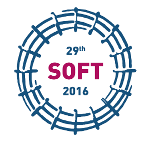Speaker
Shotaro Matsuda
(Division of Sustainable Energy and Environmental Engineering)
Description
International Fusion Material Irradiation Facility (IFMIF) is the facility generating the high flux and high energy neutron to develop a material for a nuclear fusion reactor. In the IFMIF, high-speed liquid lithium (Li) jet is used as the target irradiated by two deuteron beams. Since the Li jet must flow with high velocity for the heat removal, it is important to research on the characteristics of Li flow. Laser probe method has been developed as a promising measurement method of target flow characteristics with non-contact measurement and demonstrated as one of the task in IFMIF/EVEDA. These researches have been aimed toward the steady-state flow characteristics of the Li jet. On the other hand, in the actual IFMIF, it is also necessary to clarify transient flow characteristics at start and stop of the system for the operation because of the target flowing along with a vertical and a concave flow channel. In this study, water experiment to obtain them at start and stop is thus conducted using laser probe method. Water can be substituted for liquid Li as the target, because the kinematic viscosity of the Li at the operation temperature in the IFMIF is nearly equal to that of water at normal temperature and pressure. Water loop used in this experiment mainly consists of a two-staged contraction nozzle, a vertical and a concave flow channel, a gas release valve, a pump and a buffer tank. In addition to laser probe, high-speed video camera is used to observe the flow pattern of the water jet. As a result, it was confirmed that the surface fluctuation at start and stop of flow became larger than that at steady-state. The flow at the stop also became stable by venting gas from the release valve.
Co-authors
Eiji Hoashi
(Division of Sustainable Energy and Environmental Engineering, Graduate School of Engineering Osaka University, Osaka, Japan)
Hiroo Kondo
(Japan Atomoc Energy Agency, Ibaraki, Japan)
Hiroshi Horiike
(Department of Applied Nuclear Technology, Faculty of Engineering Fukui University of Technology, Fukui, Japan)
Sachiko Yoshihashi
(Department of Applied Nuclear Technology, Faculty of Engineering Fukui University of Technology, Fukui, Japan)
Sayaka Kaji
(Department of Applied Nuclear Technology, Faculty of Engineering Fukui University of Technology, Fukui, Japan)
Shotaro Matsuda
(Division of Sustainable Energy and Environmental Engineering, Graduate School of Engineering Osaka University, Osaka, Japan)
Takafumi Okita
(Division of Sustainable Energy and Environmental Engineering, Graduate School of Engineering Osaka University, Osaka, Japan)
Takuji Kanemura
(Japan Atomoc Energy Agency, Ibaraki, Japan)

